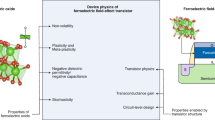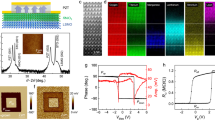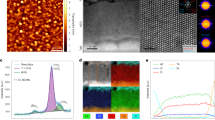Abstract
A bit more than a decade after the first report of ferroelectric switching in hafnium dioxide-based ultrathin layers, this family of materials continues to elicit interest. There is ample consensus that the observed switching does not obey the same mechanisms present in most other ferroelectrics, but its exact nature is still under debate. Next to this fundamental relevance, a large research effort is dedicated to optimizing the use of this extraordinary material, which already shows direct integrability in current semiconductor chips and potential for scalability to the smallest node architectures, in smaller and more reliable devices. Here we present a perspective on how, despite our incomplete understanding and remaining device endurance issues, the lessons learned from hafnium dioxide-based ferroelectrics offer interesting avenues beyond ferroelectric random-access memories and field-effect transistors. We hope that research along these other directions will stimulate discoveries that, in turn, will mitigate some of the current issues. Extending the scope of available systems will eventually enable the way to low-power electronics, self-powered devices and energy-efficient information processing.
This is a preview of subscription content, access via your institution
Access options
Access Nature and 54 other Nature Portfolio journals
Get Nature+, our best-value online-access subscription
$29.99 / 30 days
cancel any time
Subscribe to this journal
Receive 12 print issues and online access
$259.00 per year
only $21.58 per issue
Buy this article
- Purchase on Springer Link
- Instant access to full article PDF
Prices may be subject to local taxes which are calculated during checkout



Similar content being viewed by others
References
Buck, D. A. Ferroelectrics for Digital Information Storage and Switching. PhD thesis, MIT (1952); https://dome.mit.edu/bitstream/handle/1721.3/40244/MC665_r12_R-212.pdf?sequence=1
Auciello, O., Scott, J. F. & Ramesh, R. The physics of ferroelectric memories. Phys. Today 51, 22–27 (1998).
Gruverman, A. & Kalinin, A. Piezoresponse force microscopy and recent advances in nanoscale studies of ferroelectrics. J. Mater. Sci. 41, 107–116 (2006).
Paruch, P., Giamarchi, T. & Triscone, J.-M. Nanoscale Studies of Domain Wallsin Epitaxial Ferroelectric Thin Films 339–362 (Springer, 2007); https://doi.org/10.1007/978-3-540-34591-6_8
Hytch, M., Snoeck, E. & Kilaas, R. Quantitative measurement of displacement and strain fields from HREM micrographs. Ultramicroscopy 74, 131–146 (1998).
Jia, C. L., Urban, K. W., Alexe, M., Hesse, D. & Vrejoiu, I. Direct observation of continuous electric dipole rotation in flux-closure domains in ferroelectric Pb(Zr,Ti)O3. Science 331, 1420–1423 (2011).
Junquera, J. & Ghosez, P. Critical thickness for ferroelectricity in perovskite ultrathin films. Nature 422, 506–509 (2003).
Naumov, I., Bellaiche, L. & Fu, H. Unusual phase transitions in ferroelectric nanodisks and nanorods. Nature 432, 737–740 (2004).
Dawber, M., Rabe, K. & Scott, J. Physics of thin-film ferroelectric oxides. Rev. Mod. Phys. 77, 1083–1130 (2005).
Tsymbal, E. Y. & Kohlstedt, H. Tunneling across a ferroelectric. Science 313, 181–183 (2006).
Wang, J. et al. Epitaxial BiFeO3 multiferroic thin film heterostructures. Science 299, 1719–1722 (2003).
McQuaid, R. G. P., McGilly, L. J., Sharma, P., Gruverman, A. & Gregg, J. M. Mesoscale flux-closure domain formation in single-crystal BaTiO3. Nat. Commun. 2, 404 (2011).
Xu, G. et al. Low symmetry phase in (001) BiFeO3 epitaxial constrained thin films. Appl. Phys. Lett. 86, 182905 (2005).
Catalan, G. et al. Polar domains in lead titanate films under tensile strain. Phys. Rev. Lett. 96, 127602 (2006).
Park, S.-E. & Shrout, T. R. Ultrahigh strain and piezoelectric behavior in relaxor based ferroelectric single crystals. J. Appl. Phys. 82, 1804–1811 (1997).
Noheda, B. et al. Polarization rotation via a monoclinic phase in the piezoelectric 92%(PbZn1/3Nb2/3O3)-8%(PbTiO3). Phys. Rev. Lett. 86, 3891–3894 (2001).
Baek, S. H. et al. Giant piezoelectricity on Si for hyperactive mems. Science 334, 958–961 (2011).
Böscke, T. S., Müller, J., Bräuhaus, D., Schröder, U. & Böttger, U. Ferroelectricity in hafnium oxide thin films. Appl. Phys. Lett. 99, 102903 (2011).
James, D. High-k/metal gates in the 2010s. In 25th Annual SEMI Advanced Semiconductor Manufacturing Conference 431–438 (IEEE, 2014).
Schroeder, U., Hwang, C. S. & Funakubo, H. Ferroelectricity in Doped Hafnium Oxide Materials, Properties and Devices (Woodhead Publishing, 2019).
Delodovici, F., Barone, P. & Picozzi, S. Trilinear-coupling-driven ferroelectricity in HfO2. Phys. Rev. Mater. 5, 064405 (2021).
Schroeder, U. et al. Temperature-dependent phase transitions in (Hf,Zr)O2 mixed oxides: indications of a proper ferroelectric material. Adv. Electron. Mater. 8, 2200265 (2022).
Glinchuk, M. D. et al. Possible electrochemical origin of ferroelectricity in HfO2 thin films. J. Alloys Compd. 830, 153628 (2020).
Nukala, P. et al. Reversible oxygen migration and phase transitions in hafnia-based ferroelectric devices. Science 372, 630–635 (2021).
Pal, A., Wolff, N., Lofink, F., Kienle, L. & Wagner, B. Enhancing ferroelectricity in dopant-free hafnium oxide. Appl. Phys. Lett. 110, 022903 (2017).
Wei, Y. et al. A rhombohedral ferroelectric phase in epitaxially strained Hf0.5Zr0.5O2 thin films. Nat. Mater. 17, 1095–1100 (2018).
Rushchanskii, K. Z., Blügel, S. & Ležaić, M. Ordering of oxygen vacancies and related ferroelectric properties in HfO2−δ. Phys. Rev. Lett. 127, 087602 (2021).
El Boutaybi, A., Maroutian, T., Largeau, L., Matzen, S. & Lecoeur, P. Stabilization of the epitaxial rhombohedral ferroelectric phase in ZrO2 by surface energy. Phys. Rev. Mater. 6, 074406 (2022).
Lenzi, V. et al. Ferroelectricity induced by oxygen vacancies in rhombohedral ZrO2 thin films. Energy Environ. Mater. https://doi.org/10.1002/eem2.12500 (2023).
Xu, X. et al. Kinetically stabilized ferroelectricity in bulk single-crystalline HfO2. Nat. Mater. 20, 826–832 (2021).
Reyes-Lillo, S. E., Garrity, K. F. & Rabe, K. M. Antiferroelectricity in thin-film ZrO2 from first principles. Phys. Rev. B 90, 140103 (2014). http://arxiv.org/pdf/1403.3878
Lee, H.-J. et al. Scale-free ferroelectricity induced by flat phonon bands in HfO2. Science 369, 1343–1347 (2020).
Hoffmann, M., Fengler, F. & Herzig, Mea Unveiling the double-well energy landscape in a ferroelectric layer. Nature 565, 464–467 (2019).
Stolichnov, I. et al. Intrinsic or nucleation-driven switching: an insight from nanoscopic analysis of negative capacitance Hf1−xZrxO2-based structures. Appl. Phys. Lett. 117, 172902 (2020).
Lin, B.-T., Lu, Y.-W. & Chen, M.-J. Induction of ferroelectricity in nanoscale ZrO2 thin films on Pt electrode without post-annealing. J. Eur. Ceram. Soc. 37, 1135–1139 (2017).
Lee, C., Ghosez, P. & Gonze, X. Lattice dynamics and dielectric properties of incipient ferroelectric TiO2 rutile. Phys. Rev. B 50, 13379–13387 (1994).
Grünebohm, A., Entel, P. & Ederer, C. First-principles investigation of incipient ferroelectric trends of rutile TiO2 in bulk and at the (110) surface. Phys. Rev. B 87, 054110 (2013).
Gich, M. et al. Multiferroic iron oxide thin films at room temperature. Adv. Mater. 26, 4645–4652 (2014).
Mimura, T., Shimizu, T. & Funakubo, H. Ferroelectricity in YO1.5-HfO2 films around 1μm in thickness. Appl. Phys. Lett. 115, 032901 (2019).
Wei, Y. et al. Magnetic tunnel junctions based on ferroelectric Hf0.5Zr0.5O2 tunnel barriers. Phys. Rev. Appl. 12, 031001 (2019).
Sulzbach, M. C. et al. Unraveling ferroelectric polarization and ionic contributions to electroresistance in epitaxial Hf0.5Zr0.5O2 tunnel junctions. Adv. Electron. Mater. 6, 1900852 (2020).
Cheema, S. S. et al. Emergent ferroelectricity in subnanometer binary oxide films on silicon. Science 376, 648–652 (2022).
Mezzadri, F. et al. Crystal structure and ferroelectric properties of ϵ-Ga2O3 films grown on (0001)-sapphire. Inorg. Chem. 55, 12079–12084 (2016).
Clark, R. D. Emerging applications for high-k materials in VLSI technology. Materials 7, 2913–2944 (2014).
Buragohain, P. et al. Effect of film microstructure on domain nucleation and intrinsic switching in ferroelectric Y:HfO2 thin film capacitors. Adv. Funct. Mater. 32, 2108876 (2022).
Müller, J. et al. Ferroelectricity in simple binary ZrO2 and HfO2. Nano Lett. 12, 4318–4323 (2012).
Yun, Y. et al. Intrinsic ferroelectricity in Y-doped HfO2 thin films. Nat. Mater. 21, 903–909 (2022).
Lübben, M., Wiefels, S., Waser, R. & Valov, I. Processes and effects of oxygen and moisture in resistively switching TaOx and HfOx. Adv. Electron. Mater. 4, 1700458 (2018).
Goux, L. et al. Roles and effects of TiN and Pt electrodes in resistive-switching HfO2 systems. Electrochem. Solid State Lett. 14, H244–H246 (2011).
Vladislav, K., Yaramchenko, A., Navmovich, E. & Fernando, M. Research on the electrochemistry of oxygen ion conductors in the former soviet union. J. Solid State Electrochem. 4, 243–266 (2000).
Rushchanskii, K., Blugel, S. & Lezaic, M. Ab initio phase diagrams of Hf-O, Zr-O and Y-O: a comparative study. Faraday Discuss. 213, 321–337 (2019).
Patil, R. N. & Subbarao, E. C. Axial thermal expansion of ZrO2 and HfO2 in the range room temperature to 1400°C. J. Appl. Crystallogr. 2, 281–288 (1969).
Lai, A., Du, Z., Gan, C. L. & Schuh, C. Shape memory and superelastic ceramics at small scales. Science 341, 1505–1508 (2013).
Khachaturyan, A. G., Shapiro, S. M. & Semenovskaya, S. Adaptive phase formation in martensitic transformation. Phys. Rev. B 43, 10832–10843 (1991).
Wang, Y. U. Diffraction theory of nanotwin superlattices with low symmetry phase. Phys. Rev. B 74, 104109 (2006).
Jin, Y. M., Wang, Y. U., Khachaturyan, A. G., Li, J. F. & Viehland, D. Conformal miniaturization of domains with low domain-wall energy: monoclinic ferroelectric states near the morphotropic phase boundaries. Phys. Rev. Lett. 91, 197601 (2003).
Korobko, R. et al. Giant electrostriction in Gd-doped ceria. Adv. Mater. 24, 5857–5861 (2012).
Santucci, S., Zhang, H., Sanna, S., Pryds, N. & Esposito, V. Enhanced electro-mechanical coupling of TiN/Ce0.8Gd0.2O1.9 thin film electrostrictor. APL Mater. 7, 071104 (2019).
Yu, J. & Pierre-Eymeric, J. Defining giant electrostrictors. J. Appl. Phys. 131, 170701 (2022).
Park, D. et al. Induced giant piezoelectricity in centrosymmetric oxides. Science 375, 653–657 (2022).
Kelley, K. P. et al. Oxygen vacancy injection as a pathway to enhancing electromechanical response in ferroelectrics. Adv. Mater. 34, 2106426 (2022).
Park, M. H. et al. Morphotropic phase boundary of Hf1−xZrxO2 thin films for dynamic random access memories. ACS Appl. Mater. Interfaces 10, 42666–42673 (2018).
Kirbach, S., Kühnel, K. & Weinreich, W. Piezoelectric hafnium oxide thin films for energy-harvesting applications. In 2018 IEEE 18th International Conference on Nanotechnology 1–4 (IEEE, 2018).
Dutta, S. et al. Piezoelectricity in hafnia. Nat. Commun. 12, 7301 (2021).
Dreyer, C. E., Janotti, A., Van de Walle, C. G. & Vanderbilt, D. Correct implementation of polarization constants in wurtzite materials and impact on III-nitrides. Phys. Rev. X 6, 021038 (2016).
Konishi, A. et al. Mechanism of polarization switching in wurtzite-structured zinc oxide thin films. Appl. Phys. Lett. 109, 102903 (2016).
Akiyama, M. et al. Enhancement of piezoelectric response in scandium aluminum nitride alloy thin films prepared by dual reactive cosputtering. Adv. Mater. 21, 593–596 (2009).
Akiyama, M., Kano, K. & Teshigahara, A. Influence of growth temperature and scandium concentration on piezoelectric response of scandium aluminum nitride alloy thin films. Appl. Phys. Lett. 95, 162107 (2009).
Matloub, R. et al. Piezoelectric Al1−xScxN thin films: a semiconductor compatible solution for mechanical energy harvesting and sensors. Appl. Phys. Lett. 102, 152903 (2013).
Fichtner, S., Wolff, N., Lofink, F., Kienle, L. & Wagner, B. AlScN: a III–V semiconductor based ferroelectric. J. Appl. Phys. 125, 114103 (2019).
Zhu, W. et al. Wake-up in Al1−xBxN ferroelectric films. Adv. Electron. Mater. 8, 2100931 (2021).
Ferri, K. et al. Ferroelectrics everywhere: ferroelectricity in magnesium substituted zinc oxide thin films. J. Appl. Phys. 130, 044101 (2021).
Kooi, B. J. & Noheda, B. Ferroelectric chalcogenides: materials at the edge. Science 353, 221–222 (2016).
Starschich, S., Griesche, D., Schneller, D. & Böttger, U. Chemical solution deposition of ferroelectric hafnium oxide for future lead free ferroelectric devices. ECS J. Solid State Sci. Technol 4, 419–423 (2015).
Nakayama, S., Funakubo, H. & Uchida, H. Crystallization behavior and ferroelectric property of HfO2–ZrO2 films fabricated by chemical solution deposition. Jpn J. Appl. Phys. 57, 4–9 (2022).
Schenk, T. et al. Toward thick piezoelectric HfO2-based films. Phys. Status Solidi Rapid Res. Lett. 14, 1900626 (2020).
Badillo, M. et al. Low-toxicity chemical solution deposition of ferroelectric Ca:HfO2. J. Mater. Chem. C 11, 1119–1133 (2023).
Starschich, S. & Böttger, U. An extensive study of the influence of dopants on the ferroelectric properties of HfO2. J. Mater. Chem. C 5, 333–338 (2017).
Batra, R., Huan, T., Rossetti, G. & Ramprasad, R. Dopants promoting ferroelectricity in hafnia: insights from a comprehensive chemical space exploration. Chem. Mater. 29, 9102–9109 (2017).
Yao, Y. et al. Experimental evidence of ferroelectricity in calcium doped hafnium oxide thin films. J. Appl. Phys. 126, 154103–1,8 (2019).
Guo, J. et al. Cold sintering: progress, challenges, and future opportunities. Annu. Rev. Mater. Res. 49, 275–295 (2019).
Kwon, D. et al. Negative capacitance FET with 1.8-nm-thick Zr-doped HfO2 oxide. IEEE Electron Device Lett. 40, 992–996 (2019).
Mikolajic, T. et al. Next generation ferroelectric materials for semiconductor process integration and their applications. J. Appl. Phys. 129, 100901 (2021).
Boyn, S. et al. Learning through ferroelectric domain dynamics in solid-state synapses. Nat. Commun. 8, 14736 (2017).
Chanthbouala, A. et al. A ferroelectric memristor. Nat. Mater. 11, 860–864 (2012).
Di Ventra, M. & Pershin, Y. V. On the physical properties of memristive, memcapacitive and meminductive systems. Nanotechnology 24, 255201 (2013).
Boni, G. A. et al. Memcomputing and nondestructive reading in functional ferroelectric heterostructures. Phys. Rev. Appl. 12, 024053 (2019).
Ali, F. et al. Silicon-doped hafnium oxide anti-ferroelectric thin films for energy storage. J. Appl. Phys. 122, 144105 (2017).
Kim, K. D. et al. Scale-up and optimization of HfO2–ZrO2 solid solution thin films for the electrostatic supercapacitors. Nano Energy 39, 390–399 (2017).
Silva, J. P. B. et al. Energy storage performance of ferroelectric ZrO2 film capacitors: effect of HfO2:Al2O3 dielectric insert layer. J. Mater. Chem. A 8, 14171–14177 (2020).
Mart, C. et al. Energy harvesting in the back-end of line with CMOS compatible ferroelectric hafnium oxide. In 2020 IEEE International Electron Devices Meeting 26.3.1–26.3.4 (IEEE, 2020).
Hoffmann, M. et al. Stabilizing the ferroelectric phase in doped hafnium oxide. J. App. Phys. 118, 072006 (2015).
Sang, X., Grimley, E. D., Schenk, T., Schroeder, U. & LeBeau, J. M. On the structural origins of ferroelectricity in HfO2 thin films. Appl. Phys. Lett. 106, 162905 (2015).
Tobase, T. et al. Pre-transitional behavior in tetragonal to cubic phase transition in HfO2 revealed by high temperature diffraction experiments. Phys. Status Solidi B 255, 1800090 (2018).
Acknowledgements
We acknowledge financial support from the Ubbo Emmius Funds (University of Groningen). P.N. acknowledges help from J. NK in preparing Fig. 2 for this paper. SERB and IISc start up grants are also acknowledged by P.N.
Author information
Authors and Affiliations
Corresponding author
Ethics declarations
Competing interests
The authors declare no competing interests.
Peer review
Peer review information
Nature Materials thanks Florencio Sánchez and the other, anonymous, reviewer(s) for their contribution to the peer review of this work.
Additional information
Publisher’s note Springer Nature remains neutral with regard to jurisdictional claims in published maps and institutional affiliations.
Rights and permissions
Springer Nature or its licensor (e.g. a society or other partner) holds exclusive rights to this article under a publishing agreement with the author(s) or other rightsholder(s); author self-archiving of the accepted manuscript version of this article is solely governed by the terms of such publishing agreement and applicable law.
About this article
Cite this article
Noheda, B., Nukala, P. & Acuautla, M. Lessons from hafnium dioxide-based ferroelectrics. Nat. Mater. 22, 562–569 (2023). https://doi.org/10.1038/s41563-023-01507-2
Received:
Accepted:
Published:
Issue Date:
DOI: https://doi.org/10.1038/s41563-023-01507-2
This article is cited by
-
Multi-level resistive switching in hafnium-oxide-based devices for neuromorphic computing
Nano Convergence (2023)
-
Interface-type tunable oxygen ion dynamics for physical reservoir computing
Nature Communications (2023)



